Charts of the Week
Current economic trends from 16 to 20 May 2022: gross domestic product, labour market, slovenian industrial producer prices and other charts
In the first quarter of this year, real GDP growth moderated from the last quarter of 2021, while year-on-year growth remained high, mainly due to last year’s low base. Year-on-year increase in the number of persons in employment slowed in March, but remained high in the accommodation and food service activities and in construction, which are characterised by a high proportion of foreign workers. Year-on-year growth of Slovenian industrial producer prices continued to strengthen in April. Prices are rising in all industrial groups, most strongly in the domestic market. After adjusting the data for working days, industrial electricity consumption and small business electricity consumption in April reached the level of the same pre-pandemic period, as did household consumption, although this was lower year-on-year. According to data on fiscal verification of invoices, turnover in the first half of May was more than a tenth higher year-on-year in nominal terms due to higher turnover in trade and certain tourism-related services.
Gross domestic product, Q1 2022
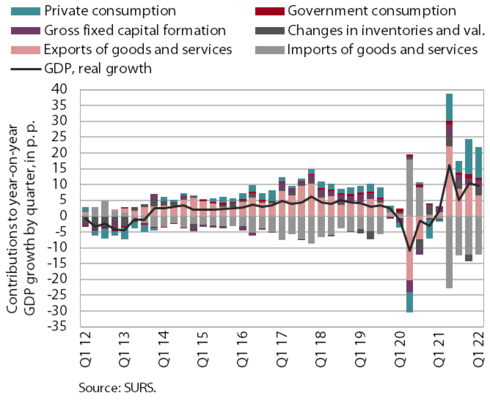
In the first quarter of this year, real gross domestic product (GDP) increased by 0.8% compared to the last quarter of 2021, which is less than in previous quarters, while year-on-year growth (9.8%) remained high, mainly due to last year’s low base. Growth in economic activity slowed, especially in the export sector, which has been struggling with supply chain disruptions and rising costs for some time, and the situation was exacerbated by the war in Ukraine. The gradual easing of containment measures and the situation on the labour market with record employment had a positive effect on the further growth of household spending. The purchasing power of households is increasingly affected by rising prices, especially of energy and food. In the first quarter, investment growth was also high year-on-year, with non-residential construction, residential construction and civil engineering in particular recording high growth this year. However, cost pressures and problems due to material shortages are increasing in the construction sector. Government consumption was also higher than in the same period last year, with growth mainly due to employment growth and an increase in spending on goods and services in the health sector.
Labour market, March 2022
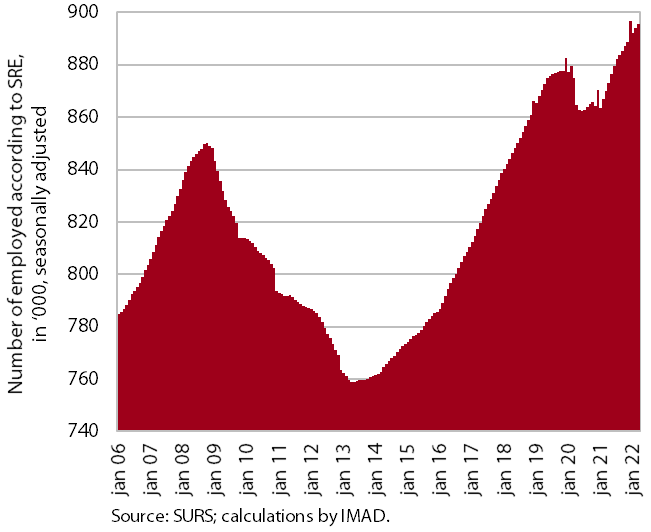
Year-on-year growth in the number of persons in employment was slightly lower in March than in the first two months of the year (2.9%). It was still very high in accommodation and food service activities and in construction. Amid economic recovery, growth in the number of persons in employment still depended largely on the employment of foreign workers, whose contribution to overall year-on-year growth was more than 50% in March. The share of foreigners among all persons in employment is also increasing, up 1.2 p.p. to 12.9% over the last year. This is largely due to the shortage of domestic labour, which (given the high vacancy rates) is greatest in construction, accommodation and food service activities and administrative and support service activities. The activities with the largest share of foreigners are construction (45%), transportation and storage (31%) and administrative and support service activities (25%).
Slovenian industrial producer prices, April 2022
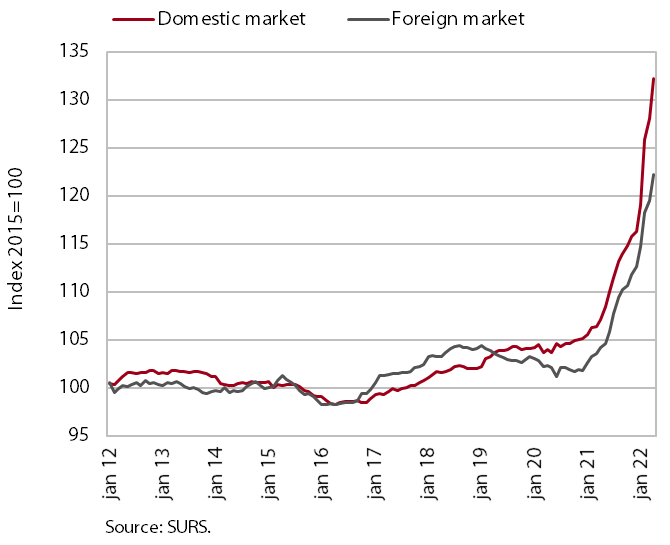
Geopolitical tensions, tighter conditions in commodity markets and supply chain bottlenecks continue to drive growth in Slovenian industrial producer prices, which already reached 20.4% year-on-year in April. Price growth has increased in all industrial groups, especially in the domestic market, where it reached 23.4% year-on-year. Overall price growth continues to be driven mainly by prices of intermediate goods, which were 27.1% higher year-on-year. Energy prices continued to record the strongest year-on-year increase (more than 60%), but their contribution to overall growth was lower due to their lesser weight compared to intermediate goods. After rising by around 10% year-on-year in the first quarter of this year, prices for capital goods rose to 12.0% in April. Growth of less than 10% was thus only recorded by the consumer goods group, where prices for durable goods were 6.6% and for non-durable goods 8.7% higher year-on-year.
Electricity consumption by consumption group, April 2022
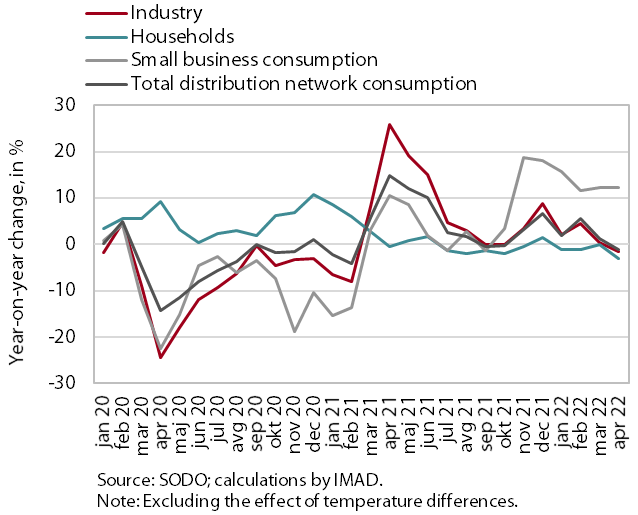
In April, industrial electricity consumption and small business electricity consumption (adjusted for working days) reached the level of the same period in 2019. With one fewer working day, industrial electricity consumption in April was 1.7% lower year-on-year, while small business electricity consumption was 12.2% higher. This was mainly due to low consumption during lockdown in early April last year when, among other things, non-essential shops and services were ordered shut. As a result, household consumption in April was 3.1% lower than a year ago. Compared to April 2019, industrial consumption was 6.5% lower and small business consumption was 3.7% lower due to two fewer working days and the less favourable timing of this year’s May Day holidays from the perspective of the functioning of the economy. After adjusting the data for working days, both consumptions reached the level of the same period in 2019. Household consumption was higher in April than in the same period of 2019 (5.2%), but the gap was smaller than in the previous month (8.5%), reflecting a better epidemiological situation and the fact that fewer people were probably working from home than in March.
Turnover based on fiscal verification of invoices, in nominal terms, 1–14 May 2022
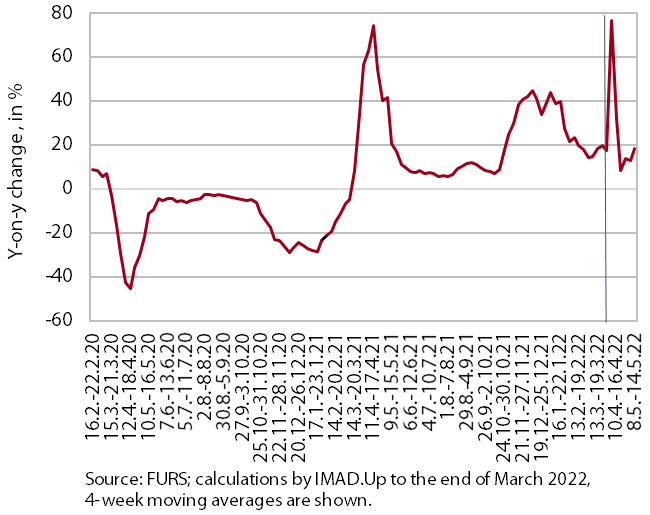
According to data on the fiscal verification of invoices, total turnover between 1 and 14 May 2022 was 13% higher year-on-year in nominal terms and 19% higher than in the same period of 2019. Year-on-year growth was similar to that in the previous two weeks. Growth was higher in trade (mainly due to higher growth in retail trade and a smaller year-on-year decline in the sale of motor vehicles), while it was lower (though still very high) in certain tourism-related services, where restrictions on business activity were gradually lifted last May.
